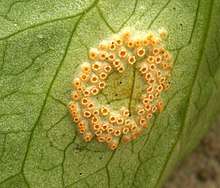Pucciniomycetes
The Pucciniomycetes (formerly known as the Urediniomycetes) are a class of fungi in the Pucciniomycotina subdivision of the Basidiomycota. The class contains 5 orders, 21 families, 190 genera, and 8016 species.[3] It includes several important plant pathogens causing forms of fungal rust.
| Pucciniomycetes | |
|---|---|
 | |
| Aecia of Puccinia sessilis on Arum maculatum leaf | |
| Scientific classification | |
| Kingdom: | Fungi |
| Division: | Basidiomycota |
| Subdivision: | Pucciniomycotina |
| Class: | Pucciniomycetes R. Bauer, Begerow, J.P. Samp., M. Weiss & Oberw. (2006)[1] |
| Orders | |
|
Helicobasidiales | |
| Synonyms[2] | |
|
Pucciniomycetes D.Hawksw., B.Sutton & Ainsw. (1983) | |
Characteristics
Pucciniomycetes develop no basidiocarp, karyogamy occurs in a thick-walled resting spore (teliospore), and meiosis occurs upon germination of teliospore. They have simple septal pores without membrane caps and disc-like spindle pole bodies. Except for a few species, the basidia, when present, are transversally septate. Mannose is the major cell wall carbohydrate, glucose, fucose and rhamnose are the less prevalent neutral sugars and xylose is not present.
References
- Bauer R, Begerow D, Sampaio JP, Weiss M, Oberwinkler F (2006). "The simple-septate basidiomycetes: a synopsis". Mycological Progress. 5 (1): 41–66. doi:10.1007/s11557-006-0502-0.
- "Pucciniomycetes R. Bauer, Begerow, J.P. Samp., M. Weiss & Oberw. 2006". MycoBank. International Mycological Association. Retrieved 2011-07-08.
- Kirk PM, Cannon PF, Minter DW, Stalpers JA (2008). Dictionary of the Fungi (10th ed.). Wallingford: CABI. pp. 580–81. ISBN 0-85199-826-7.